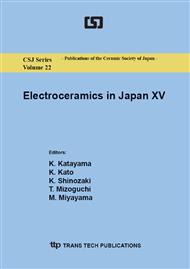p.127
p.131
p.137
p.141
p.145
p.149
p.155
p.159
p.163
Proton Storage Properties of Manganese Oxides with Tunnel Structures
Abstract:
The electrochemical capacitors (ECs) have attracted a great attention as a rechargeable strage device with a high power density and high safety. An increase in specific capacity is demanded to use ECs in various applications. MnO2 are expected as electrodes of ECs because of their large oxidation state change (Mn4+ Mn2+), low cost and environmental compatibility. When all manganese ions in the MnO2 are completely reduced to Mn2+ from Mn4+ over a potential window of 1.1 V, the theoretical capacity is estimated to about 2000 Fg-1. However, the reported capacity of MnO2 electrodes are 100250 Fg-1 [1-2] for powders and around 700 Fg-1 [3] for thin films. Tunnel structured MnO2 are expected to show high capacities by utilizing high ionic mobility in the tunnel and high surface area of tunnel walls. Fig. 1 shows crystal structures of (a) Pyrolusite (Tunnel size: 1×1), (b) Hollandite (Tunnel size: 2×2) and (c) OMS-5 (Tunnel size: 2×4) and (d) MnO6 unit. In the present study, the relationship between the tunnel size and the specific capacity was investigated for those tunnel structured MnO2. In addition, Hollandite /carbon composites were synthesized to improve the electrode properties of Hollandite.
Info:
Periodical:
Pages:
145-148
Citation:
Online since:
July 2013
Authors:
Price:
Сopyright:
© 2013 Trans Tech Publications Ltd. All Rights Reserved
Share:
Citation:


